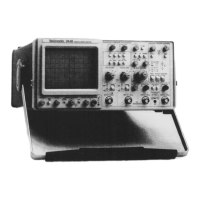Controls, Connectors, and Indicators—2445 Operators
(44) CH 2 SIGNAL OUT Connector—Provides an output
signal that is a normalized representation of the
Channel 2 input signal. The output amplitude into a
1-M12 load is approximately 20 mV per division
of input signal. Into a 50-17 load, the output ampli
tude is approximately 10 mV per division of input
signal.
(
4
?) EXT Z-AXIS IN Connector—Provides an input con
nection point to apply external Z-axis modulation
signals to the Z-Axis Amplifier. Either the sweep or
the X-Y display may be intensity modulated. Positive
going signals decrease the intensity. From dc to
2 MHz, an input-signal amplitude of +2 V will blank
a maximum-intensity trace; from 2 MHz to 20 MHz,
an input-signal amplitude of +2 V will produce
noticeable modulation on a normal-intensity trace.
Modulating signals with fast rise and fall times produce
the most abrupt intensity changes. External Z-axis
signals must be time related to the displayed signal
frequency to obtain a stable intensity-modulation
pattern on the crt.
(46) Fuse Holder—Contains the ac power-source fuse.
(
4
?) Detachable Power Cord Receptacle—Provides the
connection point for the ac power source to the
instrument.
(48) LINE VOLTAGE SELECTOR Switch-Selects the
nominal instrument operating voltage range. When
set to 115V, the instrument operates from a power-
source voltage having a range of 90 V to 132 V ac.
Set to 230V, the instrument operates on an input-
voltage range of 180 V to 250 V ac.
^ ? ) Mod Slots—Contain the identification numbers of any
installed instrument modifications.
3-10
Figure 3-6. Rear-panel controls and connectors.

